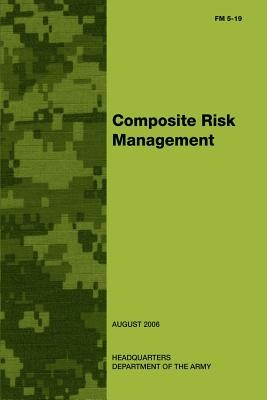
- We will send in 10–14 business days.
- Author: Department of the Army
- Publisher: CreateSpace Independent Publishing Platform
- Year: 2012
- Pages: 104
- ISBN-10: 1481022741
- ISBN-13: 9781481022743
- Format: 15.2 x 22.9 x 0.6 cm, softcover
- Language: English
- SAVE -10% with code: EXTRA
Reviews
Description
Today's Army is challenged by a wide range of threats and operating environments. These challenges, plus new technologies, require our leaders to use creative measures to provide positive protection to our Soldiers and equipment. In April 1998, Field Manual (FM) 100-14 (FM 5-19) introduced to the Army the first doctrinal publication on risk management. It detailed the application of a step-by-step process to conserve combat power and resources. This milestone manual outlined a framework that leaders could use to make force protection a routine part of planning, preparing, and executing operational, training, and garrison missions. Before the outset of the global war on terrorism it became apparent that FM 100-14 would require updating to meet the needs of the future. Army assessments also indicated that the existing manual needed to be expanded to provide clear standards and guidance on how the risk management process was to be applied. This led to this current revision. During development of this revision the Army broadened its understanding of the risk management process to encompass all operations and activities, on and off duty. This holistic approach focuses on the composite risks from all sources rather than the traditional practice of separating accident from tactical hazards and associated risks. This revision has been refocused to clearly reflect the Army's new composite approach, and has been retitled Composite Risk Management (CRM). CRM represents a culture change for the Army. It departs from the past cookie cutter safety and risk management mentality through teaching Soldiers "how to think" rather than telling them "what to think." This manual expands the context of the original FM by focusing on the application of composite risk management to the military decisionmaking process (MDMP) and the Army training management system. It further assigns the responsibilities for conducting risk management training during initial entry training and professional military education. It is a tool that works in conjunction with the Army's on-going initiative to firmly attach CRM to all Army processes. It is a milestone document for the standardization and institutionalization of the techniques, tools, and procedures that lead to sound decisionmaking and valid risk acceptance by leaders at all levels. This revision is a full rewrite of FM 100-14. It marks a break with the past by integrating the CRM process into Army operations. CRM is not a stand-alone process, a "paper work" drill, or an add-on feature. Rather, it is used as a fully-integrated element of detailed planning. It must be so integrated as to allow it to be executed intuitively in situations that require immediate action. CRM should be viewed as part of the military art interwoven throughout the Army's military decisionmaking and training management cycles.
- Author: Department of the Army
- Publisher: CreateSpace Independent Publishing Platform
- Year: 2012
- Pages: 104
- ISBN-10: 1481022741
- ISBN-13: 9781481022743
- Format: 15.2 x 22.9 x 0.6 cm, softcover
- Language: English English
Today's Army is challenged by a wide range of threats and operating environments. These challenges, plus new technologies, require our leaders to use creative measures to provide positive protection to our Soldiers and equipment. In April 1998, Field Manual (FM) 100-14 (FM 5-19) introduced to the Army the first doctrinal publication on risk management. It detailed the application of a step-by-step process to conserve combat power and resources. This milestone manual outlined a framework that leaders could use to make force protection a routine part of planning, preparing, and executing operational, training, and garrison missions. Before the outset of the global war on terrorism it became apparent that FM 100-14 would require updating to meet the needs of the future. Army assessments also indicated that the existing manual needed to be expanded to provide clear standards and guidance on how the risk management process was to be applied. This led to this current revision. During development of this revision the Army broadened its understanding of the risk management process to encompass all operations and activities, on and off duty. This holistic approach focuses on the composite risks from all sources rather than the traditional practice of separating accident from tactical hazards and associated risks. This revision has been refocused to clearly reflect the Army's new composite approach, and has been retitled Composite Risk Management (CRM). CRM represents a culture change for the Army. It departs from the past cookie cutter safety and risk management mentality through teaching Soldiers "how to think" rather than telling them "what to think." This manual expands the context of the original FM by focusing on the application of composite risk management to the military decisionmaking process (MDMP) and the Army training management system. It further assigns the responsibilities for conducting risk management training during initial entry training and professional military education. It is a tool that works in conjunction with the Army's on-going initiative to firmly attach CRM to all Army processes. It is a milestone document for the standardization and institutionalization of the techniques, tools, and procedures that lead to sound decisionmaking and valid risk acceptance by leaders at all levels. This revision is a full rewrite of FM 100-14. It marks a break with the past by integrating the CRM process into Army operations. CRM is not a stand-alone process, a "paper work" drill, or an add-on feature. Rather, it is used as a fully-integrated element of detailed planning. It must be so integrated as to allow it to be executed intuitively in situations that require immediate action. CRM should be viewed as part of the military art interwoven throughout the Army's military decisionmaking and training management cycles.


Reviews